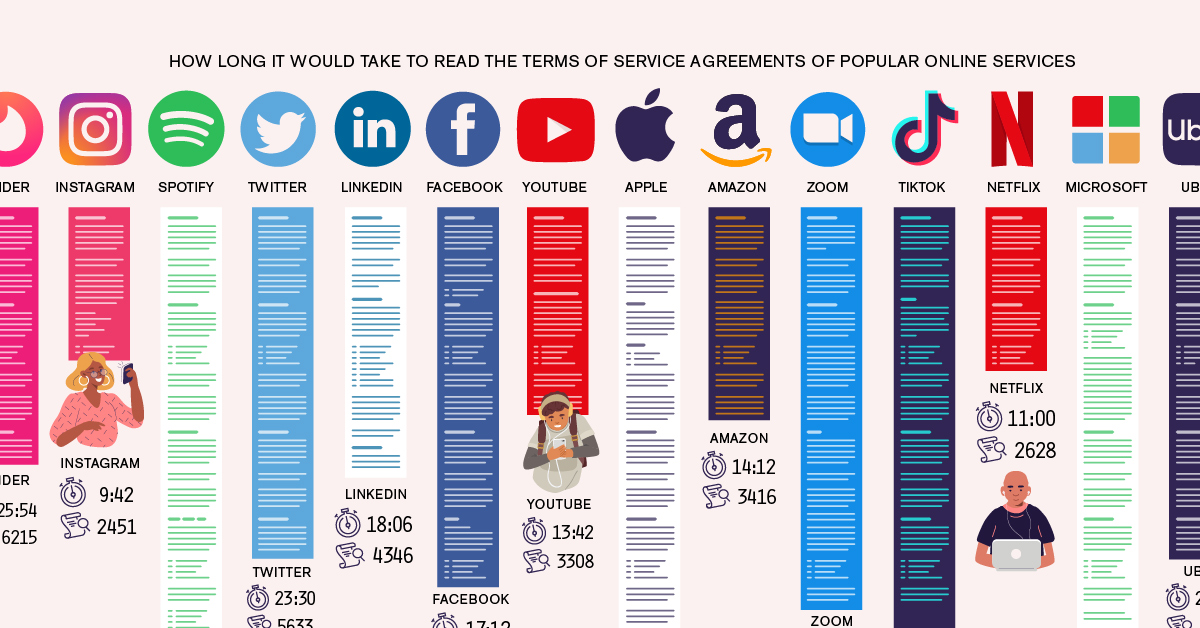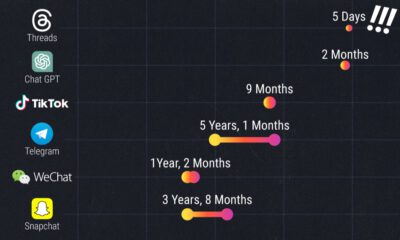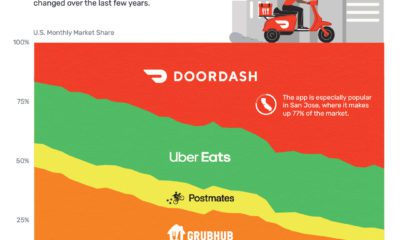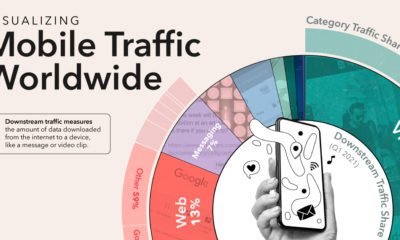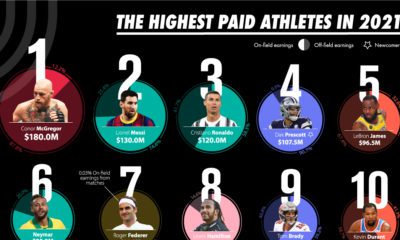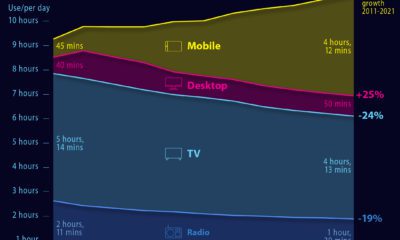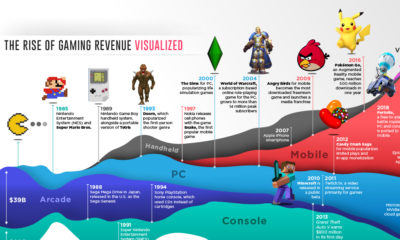Technology
Visualizing the Length of the Fine Print, for 14 Popular Apps

Terms of Service: The Length of Common Digital Contracts
Do you take the time to read the terms of service before you agree to when downloading the latest app or software?
Of course you do…
The world is awash with apps and internet services that ask potential users to agree to a service agreement. Most people click on ‘agree’ and move on, knowing that reading the service agreements could put them to sleep and defer their favorite internet fix.
Taking inspiration from designer Dima Yarovinsky’s project titled I Agree, today’s post visualizes the length of service agreements, by counting the words and calculating how long it would take users to read each one.
Ain’t Nobody Got Time for That
The average reading speed of most adults is 200 to 250 words per minute (wpm). College students, probably because they are very studious and not skimming, move that pace up to around 300 words per minute. For the sake of this analysis, we calculated reading times based on 240 wpm.
| App/Service | Word Count | How many minutes to read? (240 wpm) |
|---|---|---|
| Microsoft | 15,260 | 63.5 |
| Spotify | 8,600 | 35.8 |
| Niantic (Pokemon Go) | 8,466 | 35.2 |
| TikTok | 7,459 | 31.4 |
| Apple (Media Services) | 7,314 | 30.5 |
| Zoom | 6,891 | 28.7 |
| Tinder | 6,215 | 25.9 |
| Slack | 5,782 | 24.1 |
| Uber | 5,658 | 23.6 |
| 5,633 | 23.5 | |
| Bumble | 5,442 | 22.7 |
| Snapchat | 4,935 | 20.6 |
| 4,346 | 18.1 | |
| 4,132 | 17.2 | |
| 3,459 | 14.4 | |
| Amazon | 3,416 | 14.2 |
| YouTube | 3,308 | 13.7 |
| 3,267 | 13.6 | |
| Dropbox | 2,704 | 11.3 |
| Netflix | 2,628 | 11.0 |
| 2,451 | 9.7 |
The service agreement for Microsoft stands out at the top of the list with an agreement that would take over an hour to read — a bit less time than it would take to read Shakespeare’s Macbeth. To be fair, this service agreement does seem to cover the company’s entire suite of products.
These agreements are an insight into the legal mumbo jumbo that exists when it comes to regulating the use of these apps. There are a multitude of agreements that go even further into depth about what rules govern developers, online cash transactions and much more. The average American would need to set aside almost 250 hours to properly read all the digital contracts they accept while using online services.
Regardless, users may feel like they are wasting time reviewing a contract that can neither change or refuse—or more vitally, even comprehend.
Not All Text is Equal: The Flesch Reading-Ease Test
Apparently dealing with some of his own textual frustration, a Dr. Rudolf Flesch observed that some text, in particular legal language, appeared to be written to make reading as difficult as humanly possible.
Long sentences filled with arcane words can drag out simple sentences and discourage comprehension. Flesch wanted to measure the variability in reading comprehension — and by studying different kinds of writing, he developed a formula to determine readability and forever scorn lawyers.
In the Flesch Reading-Ease test, higher scores indicate material that is easier to read. Lower numbers mark passages that are more difficult to read. The formula for the Flesch Reading-Ease Score (FRES) test is:

The readability score uses two metrics:
- The numbers of words per sentence
- The number of syllables per word
Based on this score, a text would correspond to a particular education level.
| Score | Grade | Avg. Words per sentence | Syllables per 100 words |
|---|---|---|---|
| 100-90 | 5th grade | 8 | 123 |
| 90.0-80.0 | 6th grade | 11 | 131 |
| 90.0-70.0 | 7th grade | 14 | 139 |
| 70.0-60.0 | 8th and 9th grade | 17 | 147 |
| 60.0-50.0 | 10 to 12th grade | 21 | 155 |
| 50.0-30.0 | College | 25 | 167 |
| 30.0-0.0 | College graduate | 29 | 192 |
So how do the service agreements in our sample rank in terms of the Flesch Reading-Ease test?
| App/Service | Flesch Reading Ease Score | Equivalent Grade Level |
|---|---|---|
| 56 | 10 to 12th grade | |
| 56 | 10 to 12th grade | |
| 54 | 10 to 12th grade | |
| 54 | 10 to 12th grade | |
| Microsoft | 54 | 10 to 12th grade |
| Snapchat | 54 | 10 to 12th grade |
| Dropbox | 51 | 10 to 12th grade |
| Bumble | 50 | College level |
| YouTube | 50 | College level |
| 48 | College level | |
| Apple Media Services | 47 | College level |
| Tinder | 46 | College level |
| Amazon | 45 | College level |
| Netflix | 45 | College level |
| TikTok | 44 | College level |
| Spotify | 44 | College level |
| Zoom | 42 | College level |
| Uber | 40 | College level |
| 39 | College level | |
| Niantic (Pokemon Go) | 39 | College level |
| Slack | 36 | College level |
While not the most difficult to read, they definitely include a fair amount of legalese that helps discourage reading. The length and the difficulty of reading these agreements makes them practically useless to the average person.
This is a problem because it undermines basic concepts of contracts and informed consent. Users are giving up their rights without their knowledge.
Terms of Service: You Are the Product
These apps and software are the forefront of the data collection for a multi-billion dollar industry.
Individual user activity and information get easily collected and stored, creating databases of user patterns. This type of behavioral information makes marketers salivate, allowing them target their products to their ideal audience at lower costs than traditional advertising.
Do you know what you have agreed to?
Technology
All of the Grants Given by the U.S. CHIPS Act
Intel, TSMC, and more have received billions in subsidies from the U.S. CHIPS Act in 2024.

All of the Grants Given by the U.S. CHIPS Act
This was originally posted on our Voronoi app. Download the app for free on iOS or Android and discover incredible data-driven charts from a variety of trusted sources.
This visualization shows which companies are receiving grants from the U.S. CHIPS Act, as of April 25, 2024. The CHIPS Act is a federal statute signed into law by President Joe Biden that authorizes $280 billion in new funding to boost domestic research and manufacturing of semiconductors.
The grant amounts visualized in this graphic are intended to accelerate the production of semiconductor fabrication plants (fabs) across the United States.
Data and Company Highlights
The figures we used to create this graphic were collected from a variety of public news sources. The Semiconductor Industry Association (SIA) also maintains a tracker for CHIPS Act recipients, though at the time of writing it does not have the latest details for Micron.
| Company | Federal Grant Amount | Anticipated Investment From Company |
|---|---|---|
| 🇺🇸 Intel | $8,500,000,000 | $100,000,000,000 |
| 🇹🇼 TSMC | $6,600,000,000 | $65,000,000,000 |
| 🇰🇷 Samsung | $6,400,000,000 | $45,000,000,000 |
| 🇺🇸 Micron | $6,100,000,000 | $50,000,000,000 |
| 🇺🇸 GlobalFoundries | $1,500,000,000 | $12,000,000,000 |
| 🇺🇸 Microchip | $162,000,000 | N/A |
| 🇬🇧 BAE Systems | $35,000,000 | N/A |
BAE Systems was not included in the graphic due to size limitations
Intel’s Massive Plans
Intel is receiving the largest share of the pie, with $8.5 billion in grants (plus an additional $11 billion in government loans). This grant accounts for 22% of the CHIPS Act’s total subsidies for chip production.
From Intel’s side, the company is expected to invest $100 billion to construct new fabs in Arizona and Ohio, while modernizing and/or expanding existing fabs in Oregon and New Mexico. Intel could also claim another $25 billion in credits through the U.S. Treasury Department’s Investment Tax Credit.
TSMC Expands its U.S. Presence
TSMC, the world’s largest semiconductor foundry company, is receiving a hefty $6.6 billion to construct a new chip plant with three fabs in Arizona. The Taiwanese chipmaker is expected to invest $65 billion into the project.
The plant’s first fab will be up and running in the first half of 2025, leveraging 4 nm (nanometer) technology. According to TrendForce, the other fabs will produce chips on more advanced 3 nm and 2 nm processes.
The Latest Grant Goes to Micron
Micron, the only U.S.-based manufacturer of memory chips, is set to receive $6.1 billion in grants to support its plans of investing $50 billion through 2030. This investment will be used to construct new fabs in Idaho and New York.
-

 Education1 week ago
Education1 week agoHow Hard Is It to Get Into an Ivy League School?
-

 Technology2 weeks ago
Technology2 weeks agoRanked: Semiconductor Companies by Industry Revenue Share
-

 Markets2 weeks ago
Markets2 weeks agoRanked: The World’s Top Flight Routes, by Revenue
-

 Demographics2 weeks ago
Demographics2 weeks agoPopulation Projections: The World’s 6 Largest Countries in 2075
-

 Markets2 weeks ago
Markets2 weeks agoThe Top 10 States by Real GDP Growth in 2023
-

 Demographics2 weeks ago
Demographics2 weeks agoThe Smallest Gender Wage Gaps in OECD Countries
-

 Economy2 weeks ago
Economy2 weeks agoWhere U.S. Inflation Hit the Hardest in March 2024
-

 Environment2 weeks ago
Environment2 weeks agoTop Countries By Forest Growth Since 2001



